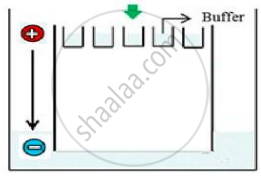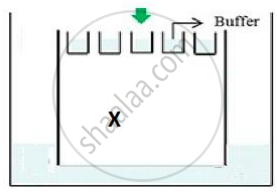Advertisements
Advertisements
Question
Carefully observe the given picture. A mixture of DNA with fragments ranging from 200 base pairs to 2500 base pairs was electrophoresed on agarose gel with the following arrangement.

(a) What result will be obtained on staining with ethidium bromide? Explain with reason.
(b) The above setup was modified and a band with 250 base pairs was obtained at X.

What change(s) were made to the previous design to obtain a band at X? Why did the band appear at position X?
Solution
(a) No bands will be obtained as all DNA will be seen in the well only; DNA fragments being negatively charged will not move towards the negative end/cathode. DNA being negatively charged will remain stationed at the positive end/anode end of the agar block.
(b)
- The position of the positive terminal/end/anode and the negative terminal/end/cathode was inter-changed.
- The fragment with the least base pairs will get separated faster and move faster to the anode end.
APPEARS IN
RELATED QUESTIONS
Suggest a technique to a researcher who needs to separate fragments of DNA.
Name and describe the technique that helps in separating the DNA fragments formed by the use of restriction endonuclease
Do eukaryotic cells have restriction endonucleases? Justify your answer.
How does restriction endonuclease function?
The DNA fragment separated on an agarose gel can be visualized by staining with ______.
Molecular scissors, which cut DNA at specific site is ______.
DNA fragments separate according to size through?
Which of the given statements is correct in the context of visualizing DNA molecules separated by agarose gel electrophoresis?
Which of the following bacteria is not a source of restriction endonuclease?
A plasmid DNA and a linear DNA (both are of the same size) have one site for a restriction endonuclease. When cut and separated on agarose gel electrophoresis, plasmid shows one DNA band while linear DNA shows two fragments. Explain.
